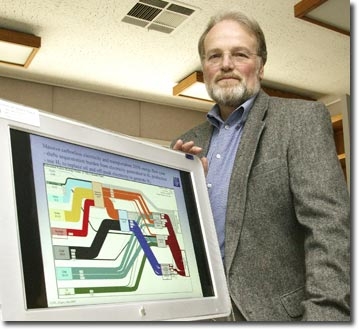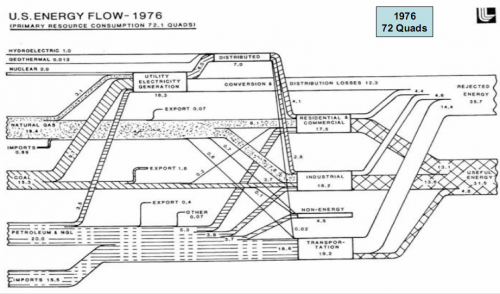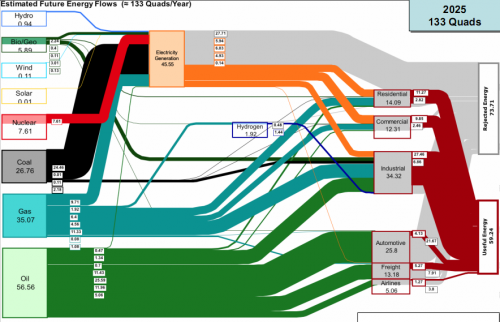The Council on Competitiveness has just called on the presidential candidates to come up with a national energy plan, believing that future economic growth and security of the United States depends on energy efficiency across the U.S. economy, sustainable energy solutions, and development of new technologies.
The new president might want to ask John Ziagos to advise him on energy issues. Ziagos is with the Energy & Environment Directorate at Lawrence Livermore National Laboratories, and an expert for energy scenarios. For me as a Sankey aficionado he is simply the “man behind the Sankey diagrams at LLNL”.
LLNL has been publishing energy flow diagrams for the U.S. over the last few years. In his public presentations (link1 – 2.9 MB, link2 – 4.8 MB) Ziagos impressively shows that even when implementing fuel cell technology for all vehicles, switching completely from coal and natural gas to renewable energy sources to generate the nation’s electricity, and building 270 new nuclear power plants … even then it would not be possible to stabilize U.S. carbon emissions between now and 2050. “If we want to move toward a carbonless future, no single technology will do – everything counts.” Ziagos says.
I am reproducing two energy flow diagrams for the U.S. from John’s presentations below. The first is for 1976…
… the second a 2025 projection:
While overall energy produced will rise from 72 Quads in 1976 to an estimated 133 Quads p.a. in 2025 [Note: 1 Quad(rillion) equal to 10E15 BTU, or 1.055 × 10E18 joules (1.055 exajoules or EJ) in SI units.], the ratio of useful energy to rejected energy gets worse.



9 Comments
Can you clarify what “rejected energy” means. why is it rejected?
Rejected energy refers to energy that is wasted due to inefficiencies in the system. i.e due to heat, transmission losses etc etc
Rejected energy comes mainly from electricity generation and transportation.
For electricity generation, the most modern gas-fired generating stations are at best ~50% efficient with the rest wasted. There are also losses of 5~10% in transmission of electricity.
For transport, the internal combustion engine has an efficiency of ~25%, the rest is considered waste.
I have one question. About the division between ”useful” or ’’rejected’’ energy is depends on assumed efficiencies. I’m curiously that what’s the end use efficiency in the residential, commercial and industrial, transportation sectors. How to calculate it ?I hope someone could kindly reply the questions. Thanks very much!
Comments are closed.